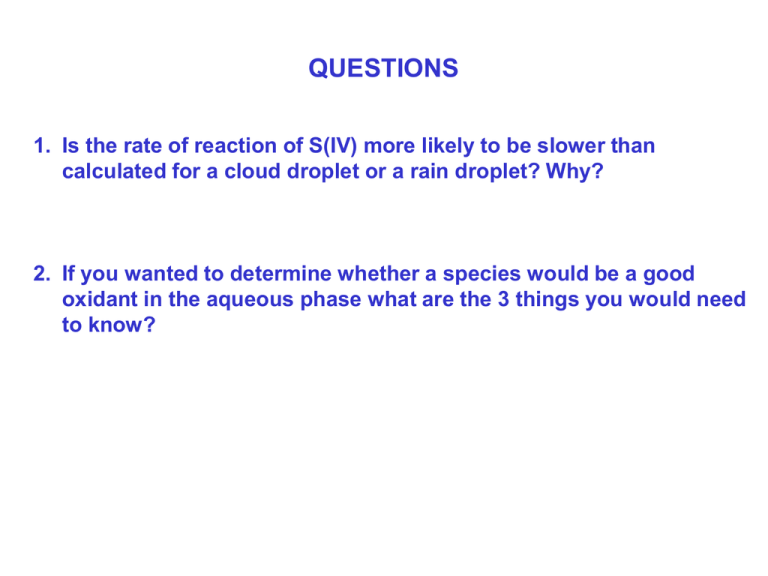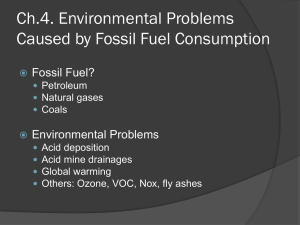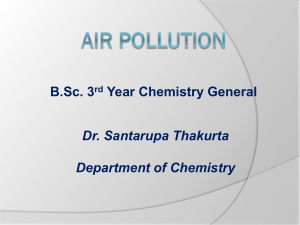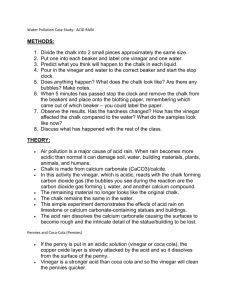post_lecture21_ats621_acidrain_chap13
advertisement

QUESTIONS 1. Is the rate of reaction of S(IV) more likely to be slower than calculated for a cloud droplet or a rain droplet? Why? 2. If you wanted to determine whether a species would be a good oxidant in the aqueous phase what are the 3 things you would need to know? CHAPTER 13: ACID RAIN NATURAL pH OF RAIN • Equilibrium with “natural” CO2 (280 ppmv) results in a rain pH of 5.7: H 2O CO2 H 2O CO2 ( g ) K H 3 102 M atm-1 HCO3 H K1 9 107 M CO2 H 2O CO32 H HCO3 K 2 7 1010 M [ H ] ( K1KH PCO2 )1/2 This pH can be modified by natural acids (H2SO4, HNO3, RCOOH…) and bases (NH3, CaCO3) natural rain has a pH in range 5-7 “Acid rain” refers to rain with pH < 5 damage to ecosystems ENVIRONMENTAL IMPACTS OF ACIDITY PRECIPITATION PH OVER THE UNITED STATES: 1994 CHEMICAL COMPOSITION OF PRECIPITATION Electoneutrality condition for acid rain based on predominant ions: [H+] + [NH4+] +2[Ca2+] = 2[SO42-] + [NO3-] PH MEASURED IN CLOUD AND FOG WATER Courtesy: Jeff Collett GLOBAL SULFUR BUDGET [Chin et al., 1996] (flux terms in Tg S yr-1) cloud, H+, H2O2 42 SO2 4 NO3 18 t 3.9d OH t 1.3d 8 SO42- H2SO4(g) OH (CH3)2S DMS t 1.0d 10 64 dep 27 dry 20 wet 22 Phytoplankton Volcanoes Combustion Smelters dep 6 dry 44 wet SULFUR CHEMISTRY Aside: dissociation of sulfuric acid: H2SO4 (aq) SO42 2H Gas phase oxidation: SO2 + OH … H2SO4 slow, lifetime of SO2 ~weeks In cloud oxidation (focus here on H2O2 oxidation at low pH): SO2(g) SO2.H2O (13) SO2.H2O HSO3- + H+ (14) H2O2(g) H2O2(aq) (15) HSO3- + H2O2(aq) + H+ SO42- + 2H+ + H2O (16) Remember equilibrium constants: [SO2 H 2O] K13 PSO2 etc…. Rate of aqueous phase sulfate formation therefore: d [ SO42 ] k16 [ HSO3 ][ H 2O2 (aq)][ H ] dt k16 K13 K14 K15 PSO2 PH 2O2 R16 very fast: Titrates either SO2 or H2O2 in a cloud GLOBAL SULFUR EMISSION TO THE ATMOSPHERE 2001 estimates (Tg S yr-1): Industrial 57 Volcanoes 5 Ocean 15 Biomass burning 1 Chin et al. [2000] H2SO4 (aq) SO42 2H Efficient scavenging of both HNO3(g) and nitrate aerosol HNO3 (aq) NO3 H Efficient scavenging of both NH3(g) and ammonium aerosol NH3 (aq) H NH4 BUT ECOSYSTEM ACIDIFICATION IS PARTLY A TITRATION PROBLEM FROM ACID INPUT OVER MANY YEARS Acid flux FH+ Acid-neutralizing capacity (ANC) from CaCO3 and other bases t F H 0 dt ANC acidification AREAS (IN BLACK) WITH LOW ACID-NEUTRALIZING CAPACITY ACID RAIN: US-CANADA ENVIRONMENTAL POLICY ISSUE OF 1970’s - 1980’s http://archives.cbc.ca/environment/pollution/topics/584/ Dying lakes, dying crops A long awaited agreement A policy debate that was ultimately addressed with domestic legislation (Eastern Canada Acid Rain Program in 1985 and US amendment to Clean Air Act in 1991) EXCESS NITROGEN DEPOSITION CAN ALSO LEAD TO EUTROPHICATION OF LAKES AND RIVERS Excessive deposition of assimilable N eutrophication accumulation of algae suppression of supply of O2 to deep water hypoxia N inputs to the Chesapeake Bay have increased 7-fold over natural! 1987 agreement to reduce N inputs by 40% Watershed estimates of controllable N inputs to Chesapeake [Boesch et al., 2001] SOLUTIONS TO ACID DEPOSITION? CHEMICAL: Liming – addition of calcium carbonate. Works, but is expensive and only a short term solution BIOLOGICAL: Long-term solution – reduce emissions and let lakes recover naturally www.life.uiuc.edu/ib/349/lectures/Aci d04.ppt TRENDS IN U.S. EMISSIONS OF SO2 AMMONIUM AND SULFATE TRENDS, 1985-2004 NH4+ SO42Lehmann et al. [2007] CHANGE IN PRECIPITATION PH FROM 1994 TO 2008 DEPLETION OF BASE CATIONS FROM ACID RAIN (Hubbard Brook Experimental Forest, New Hampshire) STILL A MAJOR CONCERN IN INDUSTRIALIZING NATIONS…











